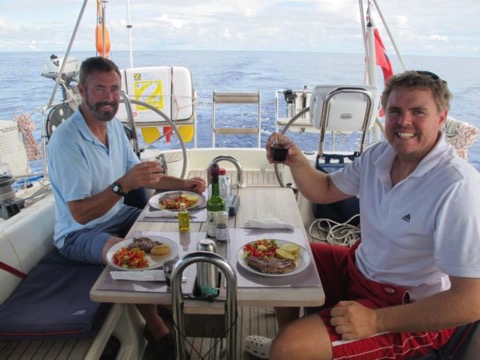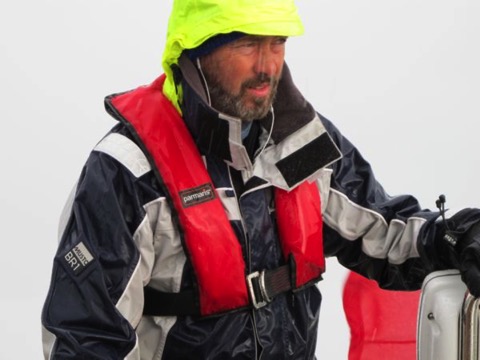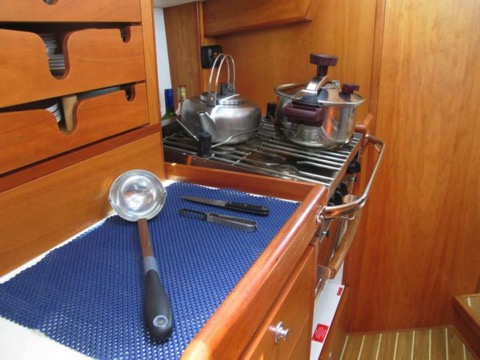10 Tips for Cooking at Sea
By Sheryl Shard, Copyright 2015. All rights reserved.
Up until now most of my newsletters have focused on our travels with the aim of sharing our experiences to help you plan your own adventures in the many different destinations we have visited during 23 years of international cruising. But one of the most popular boat show seminars we conduct is "Outfitting and Provisioning for Cruising", so I thought for a change that I’d write about something related to this and Life On Board. Today’s topic is Cooking at Sea.

A calm day on the Atlantic with Paul and friend, Matt Heron. After days of rough weather and strenuous watch-keeping during the 2012 Atlantic Rally for Cruising (ARC) it was nice to have a sit-down meal together in the cockpit . Photo by Sheryl Shard
One of the things Paul and I love about cruising is that we have more time to prepare and enjoy delicious meals than when we’re rushing around during our busy lives ashore. We love to shop in foreign markets, experiment with new foods, and entertain friends aboard our Southerly 49 sailboat, Distant Shores II.

Cured ham at the city market in Valencia, Spain. Photo by Paul Shard.
When on passages, however, food preparation takes on a different meaning and significance. Good nutritious meals are important to maintaining our health and energy at sea, not to mention our sense of well-being when spending weeks in isolation on an ocean crossing. But the physical challenges of passage-making sometimes make meal preparation an energy-depleting exercise. In rough weather it can be downright dangerous.

Paul at the helm after wet crossing of the North Sea from Shetland to Norway. Photo by Sheryl Shard

The galley on our Southerly 49 sailboat, Distant Shores II, set up for sea. Photo by Sheryl Shard.
Top 10 tips for Cooking at Sea
1. Prepare meals ahead of time: Before leaving on a passage, we try to prepare as many meals as possible before we leave the dock. It takes a few days for your body to adjust to around-the-clock watch routines so make everything easy. Like many long-distance sailors, Paul is especially susceptible to seasickness during the first 3 days of a passage so we plan light, easily digestible foods.
2. Store everything you need for meal preparation near the galley: If everything is close at hand, you will do a better job of preparing good meals since it will be less tiring than running here and there digging deep in lockers on a pitching boat. You will also be less likely to fall or injure yourself.
3. Know what you’ve got and where it is: Don’t waste your time and energy digging through lockers unnecessarily. Keep a good inventory list so you know exactly what you’ve got and where it is.
4. Top everything up before you leave the dock: Running out of dish detergent, having to change a toilet paper roll or finding the flour canister empty can bring me to tears if a storm is raging. Topping everything up before you leave the dock reduces effort and irritation.
5. Clean the boat like crazy: Odours can do you in if you’re on the verge of “mal de mar”. Make sure there are no sour sponges, dirty dish towels, gruesome laundry or icebox gremlins waiting to turn your stomach. Do your best to clean up spills so you don’t slip and fall. Check your fresh produce supply regularly so you’re not caught out by a rotting potato or mildewed melon.
6. Add safety features and use them: The safer you feel in the galley, the more pleasant your galley tasks will be. There should be lots of handholds in the galley and a galley strap at the stove so when the going gets rough the chef doesn’t land in the soup. We have pot clamps on our gimballed propane stove to keep things where they should be. We have a stainless steel safety bar in front of the stove (between the cook and “the cooker”) for added protection from burns. At sea I also cover our countertops with non-skid mats to keep bowls and utensils from flying around.
7. Keep it simple: When the weather is rough, it’s really better to stay out of the galley, if possible. Design meals to be quick and easy. We snack a lot on passages, especially in foul weather, often having several small meals rather than three major productions per day. It’s easier on the digestion and easier on the cook.
8. Come up for air: Stick your head out the companionway occasionally if you’re going to be in the galley for a while. It clears your head and makes you feel better.
9. Make clean-up easy: Design your meals so clean-up isn’t a major chore. One-pot dinners served on paper plates makes life easier for everyone when the going gets rough.
10. Make time to sit together and eat: Being only 2 people on a yacht most times while underway can make it tempting to alternate long watches and pass each other like ships in the night. Help your relationship and avoid loneliness by sitting and eating together. Even if it is only for 10 minutes, take the time to catch up and ask each other how you're feeling.

Join our email list and get hints, technical articles and tips plus videos to help you achieve your cruising dreams.
- FREE 1/2 hour video on cruising the Exuma Islands in the Bahamas
- Technical Blog shows you how to deal with issues facing the cruising sailor
- Destination information from some of the world's best cruising areas
- Special discounts and promotions
Click Here to Sign up
You Might also like the following...
Tropical Storm Chantal Arrives
Making Money While Cruising
Maintaining a Homebase
About the Southerly 49
Top 10 Canal Journeys
blog comments powered by Disqus